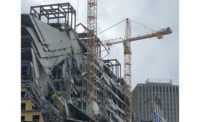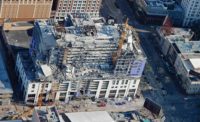For a full year, the wreckage of the collapsed Hard Rock Hotel has towered over downtown New Orleans while lawsuits and citations piled up in the wake of the deadly collapse that took place during construction Oct. 12, 2019.
Monday, Oct. 12, marks the one-year anniversary of the collapse, and work to tear down the structure is not even halfway complete. Three people died and dozens were injured when the upper floors of the 18-story building pancaked on top of one another. Two victims’ bodies remained trapped in the rubble for 10 months.
The $8.4-million demolition plan calls for methodically dismantling the structure from the top down in multiple phases using cranes with wrecking balls, shears and other tools. Throughout the process, demolition crews must follow evidence preservation protocols set by attorneys litigating the numerous lawsuits over the collapse.
Structural engineer Walter Zehner, the local representative of St. Louis-based SID Engineering, says about 30% to 40% of the overall work is complete, and it might take until the end of 2020 or early 2021 before all of the debris is removed. “Everything will be back to normal in that area as far as infrastructure is concerned,” says Zehner, who is part of the demolition team led by Kolb Grading and Marschel Wrecking, both of Missouri.
Crews have been dismantling the structure piece by piece since May. Major demolition work was delayed until crews safely recovered the bodies of the two workers, Jose Ponce Arreola and Quinnyon Wimberly, in August. The body of a third victim, Anthony Magrette, was recovered two days after the October 2019 collapse, before the structure was deemed too unstable for recovery efforts to continue.
Weather and equipment issues have created setbacks. The site been shut down multiple times because of hurricane threats, and streetcar lines had to be halted to maneuver cranes.
“Our single focus right now is bringing the building down as safely and expeditiously as possible,” says Stephen Dwyer, an attorney for Hard Rock developer 1031 Canal Development LLC.
Lawsuits, Violations Mount
The project’s owners, contractors and engineers have come under intense scrutiny at almost every step of the way.
In August, the city of New Orleans filed a lawsuit in Orleans Civil District Court against 1031 Canal and more than a dozen contractors, engineers and insurers. The city claims project owner Mohan Kailas and his partners and contractors are responsible for the collapse and the resulting damages. The suit alleges the collapse and response efforts strained the city’s resources and damaged streets, infrastructure and other public property, and cost taxpayers more than $12.3 million. Dwyer would not comment on the lawsuit.
“To date, the property owners have not met their demolition deadlines, and while some progress has occurred, unfortunately the demolition remains ongoing as the one-year anniversary approaches,” city attorney Sunni LeBeouf said in a statement to ENR.
On Sept. 28, the New Orleans Fire Department responded to a one-alarm fire that broke out on the upper floors of the building. Demolition contractors were cutting steel girders when sparks ignited rolls of roofing material in the wreckage, a fire department spokesman said.
Members of the Hard Rock project team faced additional scrutiny in March, when the Occupational Safety and Health Administration, in relation to the collapse, cited lead engineer Heaslip Engineering LLC for “willful” and “serious” violations that compromised the building’s structural integrity, and imposed over $150,000 in fines. OSHA issued another $160,000 in penalties and cited 10 other companies, including general contractor Citadel Builders and steel contractor Suncoast Projects, for various safety violations. OSHA did not cite 1031 Canal.
Upper Floors Coming Down
Zehner says demolition workers have removed about 60% of the steel structure that makes up the upper floors, including two of the structure’s four sides. The streets around the site, including a section of Canal Street, can reopen once the steel structure is removed, he said.
Removing the concrete lower-level parking garage will be more straightforward, Zehner says, and will involve using concrete crushers to break up the cast-in-place structure.






